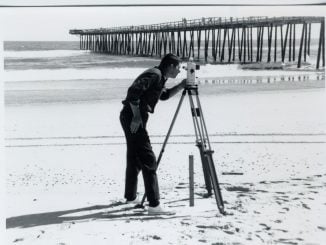In 2004, during the height of the recession, Asheville’s livestock market closed forcing producers small and large to make the drive to Tennessee or South Carolina to take their cattle to market. A drive to market for small cattle farmers meant the real possibility of losing money, not making it.”Due to stress, cattle can lose up to two percent of their body weight per hour in the first three hours of transport,” explained L.T. Ward of WNC Communities. Weight equals moneywhen you add in fuel costs and then assume that once you get the cattle to the market they would even sell for a fair pricemany a lifelong cattle farmer began to see their way out of a way of life. When cattle farms are sold and development takes over the vistas of the Blue Ridge Mountains, the views change.Neal Stamey is what is known as an old timer in the Haywood County area. “Oh, I reckon I have,” soft-spoken Stamey said when asked if he’s always been a farmer. “I worked at the paper mill, but we always kept cattle.”On auction days Stamey can be found with several other longtime Western N.C. cattle farmers gathered around a table hours before auction time sharing knowledge, stories, and community. This kind of community is a commodity that cannot be priced, and the next generation is certainly learning from it. All ages can be seen filing in getting ready for the day’s sale. One young man in particular is back again to try his hand at cattle buying.”See that young man there, he’s homeschooled, his family lives way up in the mountains,” explains Ward of WNC Communities, the main driver behind the construction of the new livestock center and the namesake of the auction center. “He came last year and bought a calf, took it home, cared for it, and brought it back and sold it for $1,200, and he’s back today to buy another.”Taking in the impression of this facility set against the mountains comes with a reminder that over time this is a rare setting that has gone from farmland to corporate and back again. “I remember it as a farm,” said lifelong resident Bill Yarborough. “It was sold to the paper company to make room for their byproduct to be landfilled, and when the time came to find a suitable site for a new livestock market for WNC, this site was one option. International Paper was gracious enough to consider a long-term lease, and the project became a reality. From farmland to an industrial landfill and now back to agriculture serving farmersthat story does not happen often, in fact, I don’t remember ever.”The 81,000 square foot facility includes the familiar trappings of offices, a snack bar, a large conference room that further serves the community as a continuing education area, and the auction center itself features recycled seating from Oriole Park at Camden Yard no less, but just beyond is a state-of-the-art outdoor open air livestock holding area large enough for 1,100 head of cattle. The moment you step through to join the buyers and sellers for the climb to the catwalk above in order to survey the livestock below it is obvious the meticulous planning and detail that went into every part of the structure. The wide center walkway that guides the cows to their appropriate paddocks is flanked by a series of swinging gates designed to facilitate their trip to the sales arena. In addition, there is a dedicated area for the veterinarian who comes weekly to check the cattle for pregnancy prior to the sale. Once plans for the center were in motion they brought in Haywood County third generation farmer and current Southeast Livestock Exchange operator, John Queen to incorporate his vision and design process in the livestock arena. You can see Queen’s careful planning throughout, multiple features of the outdoor area are designed based on Dr. Temple Grandin’s principles taking into account animal welfare, humane treatment, and the unique behavior of the livestock housed within. Building a multi-million dollar, innovative livestock center takes fundraising and facility planningnot only for the livestock arena and cattle sales but for the day-to-day operations that bring in organizations that represent the future of North Carolina cattle farming operations. The education room in the main building is often utilized by area Future Farmers of America clubs and 4-H organizations. “We have already seen cow herd numbers in the area pick back up,” said Neil Bowman of the North Carolina Department of Agriculture and Consumer Services livestock marketing division. “Without that engine there driving the educational opportunities, hands-on training, and best management practices to guide the next generation it would not be possible.”The entire process of building the Western North Carolina Regional Livestock Center is a case study in community effort. In 2004, after 50 years the Asheville Livestock market shut its doors creating a void in the market. The partnership’s response of nonprofits working with government and business led to this $3.1 million facility thriving and serving the community today. Within the first three weeks of opening 2,000 head of cattle were sold at the center, allowing farmers from 20 surrounding counties to buy and sell within North Carolina. Since the center opened in March of 2011, over 85,000 head of cattle have sold for a total of $78 milliona significant amount of money generated by a community that believed in itself.
Related Articles

Features
History marked
May 22, 1926 Establishment of Great Smoky Mountains National ParkPresident Calvin Coolidge signed a bill establishing the Great Smoky Mountains National Park. The idea to establish the park in North Carolina and Tennessee originated in […]

Features
Entertainment briefs
‘Fate of the Furious’ Rides to Third Straight No. 1 while ‘Latin Lover’ Tops Tom Hanks in ‘The Circle’It has become a familiar story “The Fate of the Furious” is, once again, the box […]

Features
Up, Up and Away!
FUQUAY-VARINA The sky was a kaleidoscope over eastern Wake County for Memorial Day weekend. The annual Freedom Balloon Fest, put on by Project Uplift USA, Raleigh Jaycees and WRAL, welcomed an estimated 80,000 visitors […]
